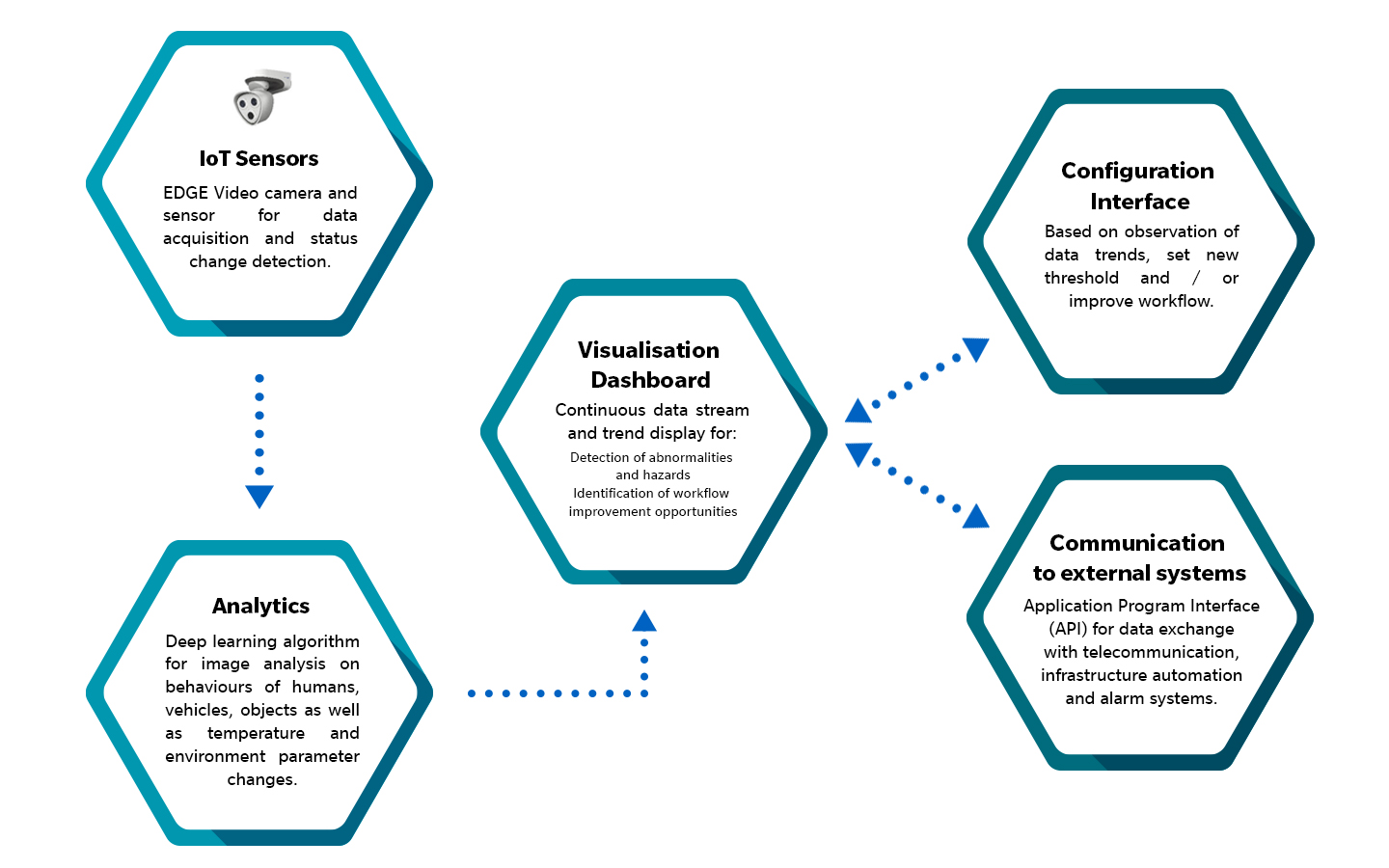
System overview
Konica Minolta IoT Smart Monitoring is a connected video solution for remote based monitoring and management. The solution has video capturing and analytic capabilities built upon image recognition and Artificial Intelligence (AI). In addition to serve security and safety purposes, it is an ideal system for building a digital twin of existing processes for workflow transformation.
SYSTEM BENEFITS
Compared to typical central processing systems that use Network Video Recording (NVR) technologies, the EDGE computing capability of Smart Monitoring allows the system to avoid single point of failure. In the event of network congestion or temporary system downtime, the Smart Monitoring cameras will provide buffer for video recording at cameras and resume storing at designated storage when network traffic is recovered. As such, we can promise higher availability of video evidence from the monitoring process.
Smart Monitoring is designed to be part of an infrastructure and to match the utility lifecycle of any building. The hardware is made in Germany and has more than 9 years of mean time between failure (MTBF). This will substantially reduce long term maintenance cost especially those of high mounted cameras that require special equipment like boom lift to physically access for maintenance.
The outdoor type of Mobotix cameras can withstand hash environment conditions and consume relative low energy to operate. It is ideal for remote areas deployment where access can be challenging, and energy source is scarce.
Built on powerful IoT functionalities, Smart Monitoring places cyber security as high priority considerations from the beginning stage of system design. It has encryption on its video recordings, software / firmware upgrade and communication among its components. This extra effort has made the system safer than other ordinary security solutions. The system also underwent cyber penetration test to expose its potential vulnerability. Eliminating the vulnerability points from the penetration test, Smart Monitoring makes life easier for system owners to address cybersecurity risk at all points on the network.
Smart Monitoring helps system owners to comply with the Personal Data Protection Act (PDPA) as it inherits the European version of General Data Protection Regulation (GDP-R).
In addition to that, the system also has compliance to US National Defense Authorization Act (NDAA). All components used in the system are tested free from banned suppliers under NDAA 2019.
As a leading brand in digital technologies, Konica Minolta, consistently commits to providing our customers with effective IoT security solutions. From solution planning and project implementation to maintenance, we assure a high level of service quality to our customers.
PRODUCT MODEL: M73
Flexible. Modular. Unique.
The M73 is a robust and weatherproof model ideal for outdoor, harsh environment deployment. This IoT camera can be configured with different day, night or thermal sensors depending on the applications. The M73 can be loaded with light-weight video analysis Apps for video analytics at the EDGE.
Description
- Decentralized EDGE architecture eliminates the need for a centralized computer and digital video recorder (DVR)
- Camera sensor with 4K UHD resolution supports multiple codec: H.264, H.265, MxPEG+ and MJPEG
- ONVIF Profile S and T conformity guarantees interoperability with video systems
- Modular flexible usage of a combination of up to three sensor / functional modules
- Support Thermal Radiometry (TR) sensor module (CIF/VGA)
- Wide Dynamic Range (WDR) with up to 120 dB
- Can be deployed under robust outdoor environment: –40 to 65 °C/–40 to 149 °F, IP66, and IK10
- General Data Protection Regulation (Regulation (EU) 2016/679) compliance
- National Defense Authorization Act 2019 (NDAA) regulations compliant camera
Specification
Download Brochure
PRODUCT MODEL: S74
Unobtrusive. Flexible. Brilliant.
The S74 provides possibilities for different needs at installation sites. For example, other than building, it is suitable to be mounted on an equipment or a vehicle. With the next generation EDGE processing power, the S74 also support configurable apps for different applications.
Description
- Compact decentralized EDGE architecture IoT video system operates without a centralized computer and digital video recorder (DVR)
- Meets all of the highest cyber security standards withstand independent penetration tests
- Camera body connected up to 4 discreet sensor modules with cable up to 3 meter apart
- Support Ultra Low Light 4 MP Day & Night optical sensor module with automatic day/night switching
- Wide Dynamic Range (WDR) with up to 120 dB
- Optional module available for thermal radiometry (TR), infra red (IR) and function modules like MultiSense.
- Support AI Apps, video analytics with deep learning capabilities
- Can be deployed under robust outdoor environment: –40 to 65 °C/–40 to 149 °F, IP66, and IK10
- General Data Protection Regulation (Regulation (EU) 2016/679) compliance
- National Defense Authorization Act 2019 (NDAA) regulations compliant camera
Specification
Download Brochure
APPLICATIONS
Konica Minolta Smart Monitoring intelligent video platform offers diverse optical and thermometry applications. Variety of Apps running on this platform are available for specific purpose of monitoring.
IoT using thermal imaging for elevated body temperature detection and monitoring
Konica Minolta Smart Monitoring uses thermal imaging cameras for contactless mass screening of potential elevated body temperature (EBT) on human traffic. Subjected to final determination using clinical approved method, this EBT detection is intended to act as first level screening to triage potential fever.
The thermal imaging cameras are connected to allow central management and reporting. Optional face recognition features can be added for attendance or visitor management. Screening results (screen shot or video), alerts and foot traffic can be forwarded to emails and push messages.

Video analytics for compliance of wearing face mask
Smart Monitoring uses a video analysis algorithm to detect the faces of the people inside a video scene and then differentiate masked and unmasked faces. The video analysis can also recognize faces if there are pre-registered profiles in database records.
The database stores both masked face profiles and those unmasked for both types of detections. Smart Monitoring can identify those who stay compliant by wearing masks and those who do not. Video footage with time stamps can serve as proof when identifying those who fail to comply.

Crowd detection for social distance compliance
Smart Monitoring also uses an algorithm to analyse the number of people in a defined video scene. As an IoT system, the smart monitoring has imaging analytic capabilities to trigger notifications when the number of people in the given video scene exceeds the allowable limit. As such, the facility owner can control the crowd by temporarily closing entrance so that social distancing can be practiced.
Same capability can also be used to detect social distancing in real time between any 2 persons in given video scene. This real time detection computes distance required between all persons (can be more than 2) present inside the video scene.

Facility safety and security
Smart Monitoring is an ideal IoT security tools that provide intelligent facility physical protection management. Video cameras with AI analytics allow facility security and management team to monitor intrusions, potential hazards, suspicious objects left behind, or objects removed. With the ability to identify the human face, vehicle plate number and object, the system can facilitate monitoring of facility access, vehicle parking and unintended object placement. When there is an event triggered, Smart Monitoring produces video records as evidence for further investigation.
Temperature monitoring with Smart Monitoring’s capabilities can also be part of occupational safety and security. As a control measure using IoT, it can mitigate risk exposure from flammable material handling. For example, the system can continuously monitor if there is temperature increase of flammable materials and automatically trigger an alert notification.





